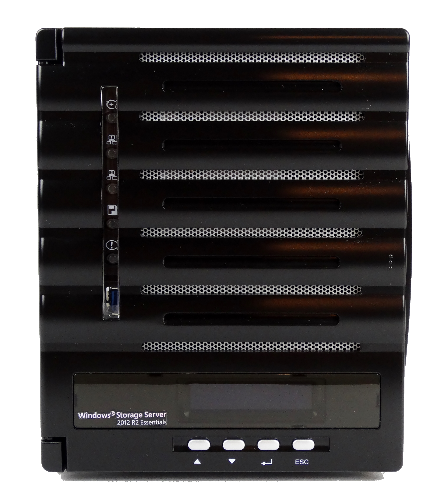Early Verdict
I've worked with the N5550, and now the W5000. The only difference is that the Linux version (N5550) ships with a DOM boot device (slow embedded storage), and the Windows version (W5000) ships with a hard drive that is 10 times faster. Somehow, the Linux version is faster than the Windows version and costs less. Save some money — don't fear preloaded Linux, and enjoy the performance benefits.
Pros
- +
Windows Server is a powerful tool that some may find easier to manage or less intimidating than Linux.
Cons
- -
Windows kills the NAS experience. From the initial setup to the application of a workload, Windows is the weak link in the W5000 NAS appliance.
Why you can trust Tom's Hardware
Introduction
And Thecus was the first company with appliances based on a new class of Windows Storage Server software, which was designed for small businesses looking for affordable, cloud-connected network-attached storage.
Windows Storage Server 2012 R2 Essentials fits between the limited WSS Workgroup and more fully featured WSS Standard software from Microsoft. Essentials uses Windows Storage Spaces like the other WSS versions (that's a fancy name for software-defined storage for SMB users). But in reality, Storage Spaces simply fills in a few more check boxes than the Windows software RAID we've had for years.
Of course, adding functionality is a good thing. Storage Spaces brings SSD caching to software RAID, though it only works in RAID 10. RAID 0, RAID 5 and RAID 6 were enhanced with DRAM buffers, but when you peel away the fancy name and write data out of cache, the performance is still reminiscent of Windows software RAID.
That isn't to say WSS doesn't have a place in the market. Despite how easy NAS companies try to make Linux configuration, Windows remains more accessible. No matter when you were born, there's a good chance that Microsoft's baby was the operating system you learned first. The name alone is a familiar greeting when you turn on a PC. People know it, use it and, regardless of how much of a pain it can be, love it. Just look at the backlash Microsoft received after trying to change it.
-
Deuce65 "Low-cost Windows Storage Servers (WSS) give small businesses access to enterprise-class features at a desktop price."Reply
Um, is this a hardware review or a press release? -
Travis Hershberger While many people may actually use RAID 5 with this device, this is what we call professional malpractice among IT pros.Reply
Ref: http://www.smbitjournal.com/2012/11/one-big-raid-10-a-new-standard-in-server-storage
http://www.smbitjournal.com/2012/11/choosing-raid-for-hard-drives-in-2013
http://www.smbitjournal.com/2012/11/choosing-a-raid-level-by-drive-count
http://www.smbitjournal.com/2013/06/dreaded-array-confusion
http://www.zdnet.com/blog/storage/why-raid-6-stops-working-in-2019/805
http://www.zdnet.com/blog/storage/why-raid-5-stops-working-in-2009/162 -
CRamseyer You need to understand a couple of things about all of those articles. The articles are not talking about your home or small business NAS with four or five drives to start with. The ZDNET author has a history of writing articles and article titles to bring people in. Many disagree with Robin's findings. I wouldn't say that is the case with the only article that relates to this review though, Why RAID 5 Stops Working in 2009. In that article he references a 7-drive RAID 5 array. With 6 or more drives we use RAID 6 (RAID 10 in some cases) for the very reason he cites. With five drives and in a home or small business environment RAID 5 is sufficient as long as you are proactive. Keep the system on a battery backup, keep air vents fee of dust and if a drive fails replace it right away.Reply
Some users may want to take redundancy to the next level and run RAID 6 on a 5 drive array. That is fine and I know people that do. I don't recommend it on a sub-1000 Dollar system that already has performance issues with RAID 5 though. -
Marco Ullasci "We rarely hear of failures in the field"Reply
Here I am.
"In our own experience, NAS failures come from easy-to-replace fans and power supplies, rather than the main components that make up the heart of the system."
Changed power supply and changed fan but still no fun.
I had to dump my DS411Slim after putting some € on it in an attempt to fix.
The brown thing happens.


